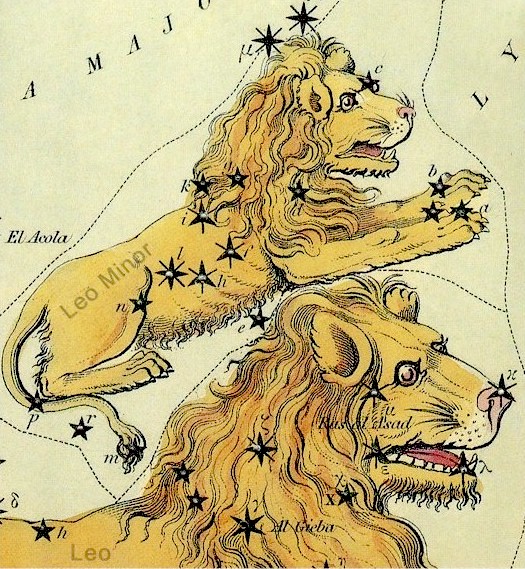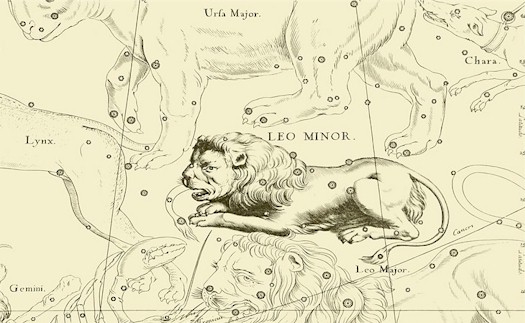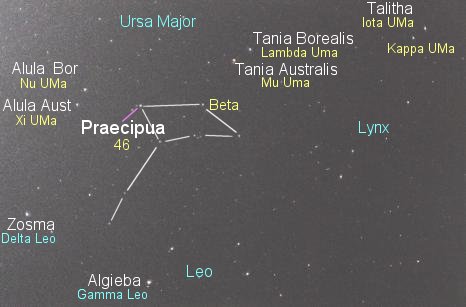Constellations of Words
Explore the etymology and symbolism of the constellations
the Lesser Lion

Urania’s Mirror1825
Contents:
1. Clues to the meaning of this celestial feature
2. The fixed stars in this constellation
3. History_of_the_constellation
Clues to the meaning of this celestial feature

Hevelius (1690)
Leo Minor, the Smaller Lion, as shown in this picture by Hevelius (1690), is the figure of a small lion positioned under the feet of the Great Bear, Ursa Major, and above the constellation Leo, the larger Lion.
The picture shows three of the Bear’s paws are placed on the ground and her right front paw is lifted – not leaving a track. The Arabs called these tracks the ‘three gazelle leaps’. Ideler, translator of Kazwini, an Arabian astronomy book, surmised that the stars of Leo Minor were the Arabs’ Al Thiba’ wa-Auladuha, the Gazelle with her Young, shown in this location on the Borgian globe.

The gazelle left tracks in the sky as it ran, they are the three pairs in Ursa Major, the three sets of ‘leaps,’ closely-spaced pairs of stars on the feet of the Bear which became the stars of Leo Minor. “Across the top of the picture are three pairs of stars that represent three feet of Ursa Major (the three gazelle ‘leaps’ of the Arabs, from right to left the third, second and first leaps). To the right of the first leap is Praecipua of Leo Minor, the Smaller Lion. The top of the Sickle of Leo is at the bottom, while the eastern end of the modern constellation Lynx is to the far right” [http://www.astro.uiuc.edu/~kaler/sow/lmi-t.html
The Leaps of the Gazelle: In ancient Arabia, before the Arabs adopted the Greek Astronomical figures for the constellations, they had different configurations in the sky. Many of starnames comes to us from this tradition.
Nu (the star: Alula Boreale) and xi (Alula Australe) marking the right hind foot of the Greater Bear (Ursa Major) were ‘the First Leap’ of the Gazelle. lambda (Tania Borealis) and mu (Tania Australis) together, marking the Bear’s left hind foot, were ‘the Second Leap’ of the Gazelle. Iota and kappa, the two Talithas together, marking the Third Leap. Each pair of stars marking one ‘spring’ or ‘leap’.
“They were collectively designated KafzahalThiba’, the Springs of the Gazelle. The Gazelle being imagined from the unformed stars since gathered up as Leo Minor, and the springing from the Pond (adjacent Coma Berenice) of the animal being due to its fear of the greater Lion’s tail (Leo). In early Arabia Coma Berenices was AlHaud, the Pond, into which the Gazelle, our Leo Minor, sprang when frightened at the lashing of the Lion’s tail (Coma Berenices is the tuft of the Lion’s tail in the Arabian figure of Leo which was a huge lion encompassing a number of our constellations); although some of the Arabic observers claimed that this Pond lay among the stars of the neck, breast, and knees of the Greater Bear Ursa Major; and Lach substituted it for the Gazelle in our location of Leo Minor. Ideler adopted this from Al Tizini and the Cufic globe at Dresden; while the Borgian globe shows a Gazelle and her Young in the same location. Kazwini, however, described this group as extending over the eyes, eyebrows, ears, and muzzle of the figure of our Ursa Major” [Allen, Star Names].
This constellation is thought to be a gazelle in the Arabic figuring. It has also been called ‘Leaena, the Lioness‘. The Aramaic word ariel seems to be a name for both for a gazelle and also for lioness? There were numerous names for lions in Middle Eastern cultures.
Ideler (German astronomer 1766–1846, translator of Kazwini, an Arabian astronomy book) surmised that the stars of Leo Minor were the Arabs’ Al Thiba’ wa-Auladuha, the Gazelle with her Young. Arabic Thiba meaning gazelle and is related to the name Tabitha. The name Tabitha is derived from an Aramaic word that meant gazelle. Greek Tabitha, from Aramaic tabhyetha, emphatic state of tabhya, ‘gazelle’, which is related to Hebrew tzebhi, feminine tzebhiyyah, Arabic zaby, Akkadian sabitu, of same meaning [Klein]. It seems that Greek Dorcas is translated from Aramaic Tabitha, in the Acts of the Apostles, she was a Christian woman of Joppa whom St. Peter raised from the dead. She was a dressmaker, who made clothes for the poor in her village. When she died, the people of the village called upon Saint Peter who is said to have raised her from the dead. [].
This constellation, Leo Minor, represents the footsteps of the Great Bear, Ursa Major, or a gazelle in the Arabic figuring, or the footprints of a gazelle (confusing?). Helice was a common classical name for Great Bear (whose tracks represent the stars of Leo Minor). Helice is the Great Bear, Ursa Major, the name Helice is cognate with the name Helen, who might also be Helen of Troy? [I have never seen Helen of Troy identified with any constellation]. Female bears might represent the ‘fallen woman’ in society; bears have loud passionate ‘love affairs’ and then part company, leaving the female pregnant and alone. This was somewhat like the experience of Callisto, identified with Ursa Major, who was a hunting partner in Artemis’ virgin group. After she became pregnant by Zeus she was cast out and turned into a bear (Ursa Major, Great Bear) for her sexual transgressions. Helen of Troy eloped with Paris, sparking the siege of Troy after her husband raised an army to take her back.
The Arabic verbal root ghazala (gazelle) means to ‘display amorous behavior; to court, woo’ [].
Layla and Majnun are 7th-century star-crossed lovers from warring Bedouin tribes in pre-Islamic Middle-East, and could not therefore marry; similar to Romeo and Juliet of Shakespeare [and maybe Ovid’s Pyramis and Thisbe]. There is a depiction in which:
“Gazelles frolic near two intertwining pine trees that grow out of star-crossed lovers Leila and Majnoons graves. Leila (Arabic, night) and Majnoon (Majnun, Arabic for love-crazed) are the Romeo and Juliet of Middle Eastern poetry and may have served as the basis for Shakespeare’s play. The gazelle, a powerful symbol in Persian and Arabic poetry and art, symbolizes feminine beauty”. http://www.boulder-dushanbe.org/ak02spring.html
In poetry, the ghazal is a [Persian or Turkish] poetic form consisting of couplets which share a rhyme and a refrain. Each line must share the same meter. Etymologically, the word literally refers to ‘the mortal cry of a gazelle’. The animal is called Ghizaal, from which the English word gazelles stems, or Kastori haran (where haran refers to deer) in Urdu. Ghazals are traditionally expressions of love, separation and loneliness, for which the gazelle is an appropriate image. A ghazal can thus be understood as a poetic expression of both the pain of loss or separation and the beauty of love in spite of that pain [].
© Anne Wright 2008.
| Fixed stars in Leo Minor | |||||||
| Star | 1900 | 2000 | R A | Decl 1950 | Lat | Mag | Sp |
| 21 | 19LEO37 | 21LEO00 | 151 07 18 | +35 29 21 | +22 05 45 | 4.47 | A5 |
| beta | 23LEO09 | 24LEO32 | 156 14 59 | +36 57 51 | +25 03 50 | 4.41 | G8 |
| Praecipua omicron | 29LEO28 | 00VIR53 | 162 37 50 | +34 29 05 | +24 55 53 | 3.92 | K2 |
History of the constellation
from Star Names, 1889, Richard H. Allen
Each after each, ungrouped, unnamed, revolve.
— Brown’s Aratos
LeoMinor, the Lesser Lion, is the French PetitLion, the German KleineLowe, and the Italian Leoncino. Proctor arbitrarily changed the title to Leaena, the Lioness.
It was formed by Hevelius from eighteen stars between the greater Lion (Leo) and Bear (Ursa Major), in a long triangle with a fainter line to the south, and thus named because he said it was “of the same nature as these adjoining constellations. Argelander assigned to it 21 components, and Heis 40, {Page 264} Aratos is supposed to have alluded to these “ungrouped, unnamed” stars under the hind paws of Ursa Major; and Ptolemy had some of them among the amorphotoi of his leon. Ideler (translator of Kazwini, an Arabian book) surmised that they were the Arabs’ AlThiba’wa-Auladuha, the Gazelle with her Young, shown in this location on the Borgian globe; but Lach (Frederick W., German scholar), that they were AlHaud, the Pond, into which the Gazelle sprang, as noted under Coma Berenices
The Chinese made two asterisms of it, — NuyPing, an Inner Screen, and SeaouWei; but also included our Lesser Lion with the Greater in their still greater Dragon mounting to the highest heavens, and in yet another figure, the StateChariot
The Denderah planisphere located here the zodiacal Crab, but whether by design, or in error, is unknown; although some see in the Lesser Lion’s stars, with others from the Bear’s feet, a well-marked Scarab that was Egypt’s idea of Cancer. This was in a part of the sky thought to have been sacred to the great god Ptah.
F1.46, 4. To the lucida Hevelius applied the adjective Praecipua, Chief, which Piazzi inserted as a proper name in the PalermoCatalogue. Burritt mentioned it, under the letter , as the Little lion, from its being the principal star in the figure.
It culminates on the 14th of April.
In Smyth’s BedfordCatalogue we read that Praecipua has three distant companions, — 7½, pale gray; 13, reddish; and 12, of violet tint.
Star Names: Their Lore and Meaning, Richard H. Allen, 1889.]
Lach (Frederick W., German scholar), that the stars of Leo Minor were Al Haud, the Pond, into which the Gazelle sprang, as noted under Coma Berenices. Allen, on p.168 under Coma Berenices, says: “In early Arabia Coma Berenice was Al Haud, the Pond, into which the Gazelle, our Leo Minor, sprang when frightened at the lashing of the Lion’s tail (Coma Berenice is the tuft of the Lion’s tail in their figure of Leo.); although some of the Desert observers (Arabian astronomers) claimed that this Pond lay among the stars of the neck, breast, and knees of the Greater Bear; and Lach substituted it for the Gazelle in our location of Leo Minor. The Gazelle being imagined from the unformed stars since gathered up as Leo Minor, and the springing of the animal being due to its fear of the greater Lion’s tail. Ideler adopted this from Al Tizini and the Cufic globe at Dresden; while the Borgian globe shows a Gazelle and her Young in the same location. Kazwini (an Arabian book), however, described this group as extending over the eyes, eyebrows, ears, and muzzle of the figure of our Ursa Major”.
Star Names: Their Lore and Meaning, Richard H. Allen, 1889. p.168, under the constellationComa Berenices]